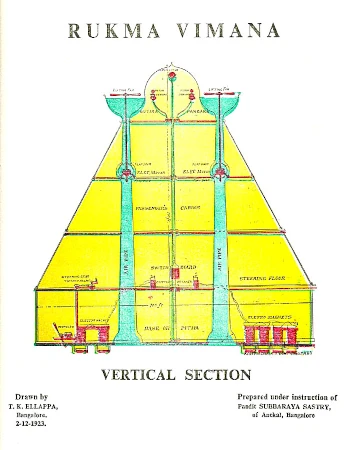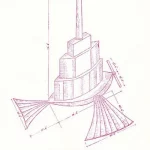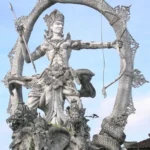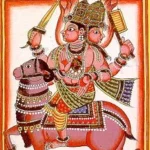The Vaimānika Śāstra (वैमानिक शास्त्र, lit. “śāstra on Vimanas”; meaning “science of aviation,” sometimes translated as Vimanika, Vymanika, Vyamanika) is a 20th-century Sanskrit text. It claims that the Vimanas mentioned in ancient Sanskrit epics were advanced, aerodynamic flying vehicles.
The VYMAANIKA-SHAASTRA AERONAUTICS was written by Maharshi Bharadwaaja, translated into English, and edited by G.R. Josyer, Director of the International Academy of Sanskrit Studies in Mysore, India.
Just before World War I, a Brahmin named Pandit Subbaraya Sastry began dictating previously unknown Sanskrit texts that purported to contain ancient Indian technical knowledge. He attributed these texts to the Vedic sage Maharshi Bharadwaja, as well as other rishis who appear in legitimate Hindu texts.
Vimanas, flying vehicles of ancient India, frequently described in the Ramayana and Mahabharata, are an interesting read for both supporters and opponents of theories of extraterrestrial contact with homo sapiens.
The Vymaanika Shastra consists of nearly 6,000 verses, or 3,000 verses in lucid Sanskrit, concerning the construction of Vimanas.
What, among other things, does the book VYMAANIKA-SHAASTRA AERONAUTICS contain?
1. In addition to the ability to fly, Vimanas possess other capabilities, such as the ability to view distant images on screens, hear distant sounds, disguise the Vimana as clouds or other images, create terrifying sounds, and so on.
2. Some Vimanas can be used as boats or submarines.
3. Information is available on the structure of the atmosphere, aviation hazards, and ways to avoid them.
4. Another interesting topic is the chapter on diet and clothing for pilots.
5. Information is available on flight in various yugas (eras): in the earliest, most spiritual yuga, humans were able to fly without any mechanical devices.
6. The text contains long lists of often bizarre ingredients used to construct various subsystems. This includes elements such as monkey skin, eagle bones, sea foam, and others that are named only in Sanskrit.
7. Most systems are described as mechanical devices, powered by steam, electricity, and even solar energy; many literally rely on smoke and mirrors. Reproduced illustrations describe non-aerodynamic, conical-shaped vehicles with enormous ornithopter wings and tiny propellers.
8. One manuscript dealt with aeronautics, the construction of various types of aircraft for civil and military purposes, and included a description of three types of vimanas: Rukma, Sundara, and Shakuna. The five hundred slokas (stanzas) on these topics contain such intricate details as the selection and preparation of metals suitable for the various parts of the various types of vimanas, their construction details, dimensions, design, and the weight they could carry, as well as the purposes for which they could be used.
9. In the chapters on materials and the selection of metals and other materials to be used in such aircraft construction, it is specified that the aircraft must be “indestructible, indestructible, incombustible, and incapable of being destroyed by accident.” Further descriptions and methods of aircraft production, which will enable pilots not only to see enemy aircraft but also to hear what enemies say in their own aircraft, similar to radar, are described in detail with appropriate explanations.
This book contains eight chapters devoted to the construction of aircraft that fly in the air, float underwater, or float on water.
10. Several slokas concern the qualification and training of pilots to operate aircraft equipped with the necessary cameras to take photographs of approaching enemy aircraft. Another set of slokas concerns the type of food and clothing that should be provided to pilots to maintain their fitness and condition under flight conditions.
Descriptions of various flying vehicles, the materials they are made of, mixing of materials and development of new alloys, the use of acids to preserve metals, use of oils for equipment and their temperatures, construction of engines for various purposes and their use depending on the vehicle’s flight altitude – these are just some of the technical information recorded in this book.
Mention should also be made of instructions for pilots on how to operate the vehicle, perform flight maneuvers, detect enemy maneuvers, determine the direction of attack and prevent them.
Such extensive instructions on the “use and operation” of flying vehicles in ancient India would hardly be expected in a place and time where advanced flying vehicles should not have existed. They should not have, yet they still appear in ancient Indian texts, providing evidence of the existence of technology that should not have existed at that time.
It’s up to us whether we treat ancient traditions as mere fairy tales or as the forgotten, real technology of extraterrestrials who visited our planet and made a leap forward in the development of Homo sapiens.
See also: https://en.wikipedia.org/wiki/Vaimānika_Shāstra
The Vimana picture’s source: Wikipedia; author: T.K.ELLAPA; License: Creative Commons Attribution-Share Alike 3.0 Unported.





